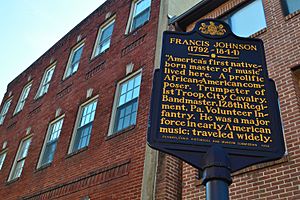Francis Johnson (composer) facts for kids
Quick facts for kids
Francis Johnson
|
|
|---|---|

Posing in Philadelphia
|
|
| Background information | |
| Also known as | Frank Johnson |
| Born | June 16, 1792 Philadelphia, Pennsylvania, U.S. |
| Died | April 6, 1844 (aged 51) Philadelphia, Pennsylvania, U.S. |
| Occupation(s) | Musician, teacher |
| Instruments | bugle, violin, piano |
| Years active | 1810s–1844 |
Francis "Frank" Johnson (born June 16, 1792 – died April 6, 1844) was an important American musician. He was also a very active composer before the American Civil War. It was rare for African American composers to be successful back then. But Johnson was one of the few who made it big.
He was an amazing player of the keyed bugle (a type of trumpet) and the violin. He wrote over 200 pieces of music. These included songs from operas, patriotic marches, and many different dance tunes. Today, we only have his handwritten music and piano versions.
Johnson was the first African American composer to have his music printed as sheet music. He was also the first African American to give public concerts. He even performed in concerts where people of all races could enjoy music together. Johnson led the first American music group to play concerts outside the U.S. He also brought a new style of concert, called the promenade concert, to America.
Biography of Frank Johnson
Francis "Frank" Johnson was born in Philadelphia, Pennsylvania on June 16, 1792. He was baptized a few months later. He led military bands and orchestras for fancy dances. He also taught music and played the violin and keyed bugle.
Early in his career, he played for balls, parades, and dance schools. He became well known in 1818 when his music was published. His career really took off in the 1820s. He played popular music for most of the big dance events in Philadelphia.
In 1837, Johnson and a small group of African American musicians traveled to England. They went to celebrate Queen Victoria becoming queen. While there, he learned about the promenade concert style. When Johnson came back from England in 1838, he introduced this new concert style in Philadelphia.
Johnson's "Voice Quadrilles" was a musical work that was very popular in London and major U.S. cities. His music, "New Cotillions and March," was played for General LaFayette. This happened when America celebrated LaFayette's visit in 1824. People in Philadelphia thought it was natural for a great musician like Johnson to play at the LaFayette Ball.
This shows how famous Johnson was. His music was even included in collections with famous composers like Beethoven and Weber. When his band toured England in 1838, Johnson played for Queen Victoria. After his performance, she gave him a silver bugle.
Johnson was very successful, even though there was a lot of unfair treatment because of his race. He got a lot of support from the public. People who heard him play said his music was amazing. He often changed the rhythm and style when he played, even if it wasn't written down. This was like how jazz musicians improvise today. He created interesting music that sounded different from other popular music of his time.
Johnson also played religious music in black churches. He performed in Philadelphia, New York, and Boston. In 1841, he put on a show called Creation at a church in Philadelphia. He later performed it at a European-American church too.
Johnson also taught music to wealthy students. One student wrote that Johnson's studio was full of instruments and music. His composing spot had unfinished music, ready for him to work on.
After Johnson passed away, his orchestra continued to play. It was led by Joseph Anderson Sr. and used music arranged by Henry F. Williams.
Frank Johnson's Music
Musical Innovations
The Philadelphia Public Ledger newspaper reported that Johnson started a new way of playing. He would sing while playing his instrument. This is more common today. It helps wind instrument players create harmonies.
In his "Bird Waltz," he used the flute to sound like chirping birds. It was so real that people couldn't tell the difference. Famous composers like Claude Debussy and Maurice Ravel might have been inspired by Johnson's ideas. Ravel's "Mother Goose" has a similar bird sound made by flutes.
Johnson's "Philadelphia Fireman's Quadrille" amazed audiences. His bugle could clearly cry, "Fire! Fire!" Johnson became known for these dramatic sound effects. Other musicians tried to copy him, but they weren't as good.
Program music became popular during this time. This is music that tells a story or describes something. Johnson arranged "The Battle of Prague." He impressed the audience with very realistic battle sounds. Johnson's "New Railroad Gallop" started with the sound of steam. Then it sounded like passengers getting on the train. It ended with the sound of the train going at full speed.
Musical Style
Sadly, we only have newspaper reviews and concert programs to tell us what Johnson's music sounded like. Back then, composers often didn't write down every note. This was because their music was in such high demand. It was easier to teach performers how to play the desired sound.
Piano versions of his music were often published for people to play at home. These helped make his band or orchestra more popular. Today, we mostly have these piano versions and basic guides for his other music. Johnson's special sound effects were more important than his simple written music. Like early jazz, his written music was simple. This allowed him to teach performers how to make it more complex and interesting.



